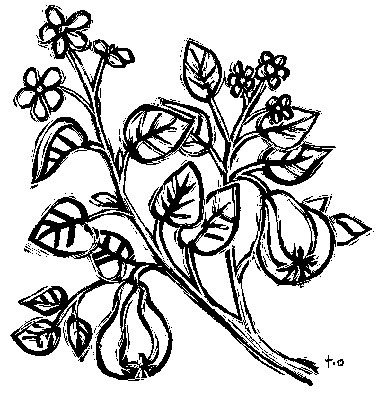 |
| Quince drawing by Toki Oshima |
By Roberta Bailey
Dating back over 4000 years and originating in Persia and Anatolia, quince was once the most popular fruit grown. In the Middle Ages, quince were so highly esteemed in France that a quince preserve or marmalade called contignac was the gift to visiting royalty. When Joan of Arc arrived to lift the siege of Orleans, the first gift offered her was contignac.
First cultivated in Mesopotamia, scions were later brought from Cydonia on the island of Crete, which produced some of the finest quince in the world, and grafted onto the cruder stock. The Latin for the tree fruiting quince is Cydonia oblongata. The best fruit of the 1600s was produced in Portugal, which is why the word ‘marmalade’ comes from ‘marmelo’, the Portuguese word for quince. Marmalade was not made from oranges until the 1790s in Dundee, Scotland.
Quince enjoyed popularity among early colonial settlers, who brought seed to North America. An old New England specialty was quince cheese, fruit preserved boiling all day until it was thick like cheese. Quince was often added to apple butter, pie and sauce. In New England, especially, quince was once popular in the commercial orchard and the home garden. Now it is the least popular of all tree fruits in the United States.
Quince fruit is pear-shaped and hard with a slightly fuzzy yellow skin. It is highly aromatic when ripe and is quite sour. Its popularity as a raw fruit dates to a time when readily available cane sugar had not biased the human palate and, later, when putting food by was a routine part of life and one sought variety for the diet in all that was locally available.
Cydonia oblonga is a small tree that grows up to 15 feet tall. It is hardy in zone 6, reaching somewhat into zone 5. It blooms white to pale pink in spring and ripens its pear-shaped fruit in fall. Its branches twist and gnarl, making it an interesting tree, hedge, or espalier subject.
The closely related flowering quince, Chaenomeles japonica or C. speciosa, forms a 4 to 8-foot shrub that is hardy to zone 4. In severe winters, the flower buds may be killed to snow line, so plant in a protected area or protect them in winter. They produce beautiful white to deep red, 1-inch blossoms in late spring and also bear a more spherical, aromatic, sour fruit of lesser quality than that of Cydonia oblonga, though they lend extremely well to cooking and preserving. In Maine we can enjoy beautiful blooms, an attractive shrub, and make our marmalade or jelly too.
All quince thrive in full sun. They grow well in average soils. Though somewhat drought tolerant, they bear more reliably in a good moist soil. A feeding of compost mulch around the base every few years is all the additional nutrient needed. As quince is susceptible to fire blight, avoid excessive nitrogen, as it produces a flush of highly susceptible new growth.
Minimal pruning is needed. Cut out branches that cross and rub against one another, and remove any dead wood. Flowering quince can be shaped as needed with minimal damage to fruit production, as quince are borne on the tips of current wood, not new growth.
Pick the fruits in the fall, when they are yellow and highly aromatic. Handle them with care: The flesh is hard, but the skin bruises easily. Store them separately or use them readily, as the fruit will flavor other food stored with it.
Quince is most often made into a delicious jelly. It is also cooked with apples in sauce and is added to fruit pies. I have had it spiced and canned like pears. (Use a recipe for spiced canned pears if none are available for quince.) I wonder if it could be made into an ade, like lemonade. It may need to be cooked first.
If you are interested in flowering quince for its fruit, seek specimens that have exceptional fruit. The shrub can be propagated by digging a piece of it with roots, or from cuttings. As the quince is also truly self-fruitful it would come true-to-type from seed. Quince can be bought bare-rooted in spring or potted throughout the summer. Pears are sometimes grafted onto quince rootstock (C. oblonga) to limit the size of the pear tree, though this is practiced more in warmer climates.
Quince is a noble and delicious fruit worthy of more attention. If you have a flowering or tree quince that is hardy and bears quality fruit, contact the author at Box 144, N. Vassalboro, ME 04962.
Quince Jelly
3 lb. fully ripe quince
4-1/2 c. water
1/4 c. lemon juice
7-1/2 c. sugar
1/2 bottle liquid pectin
Wash the fruits, removing the stem and blossom ends and cutting off the bruises. Grate the remaining flesh, including skin and core. Add water and bring to a boil in a non-reactive saucepan. Simmer 15 minutes. Press through a jelly bag or a double layer of cheese cloth. Add sugar. Process according to instructions that come with the pectin. Pour into sterile, hot jars. Seal. Water bath can for 10 minutes.
